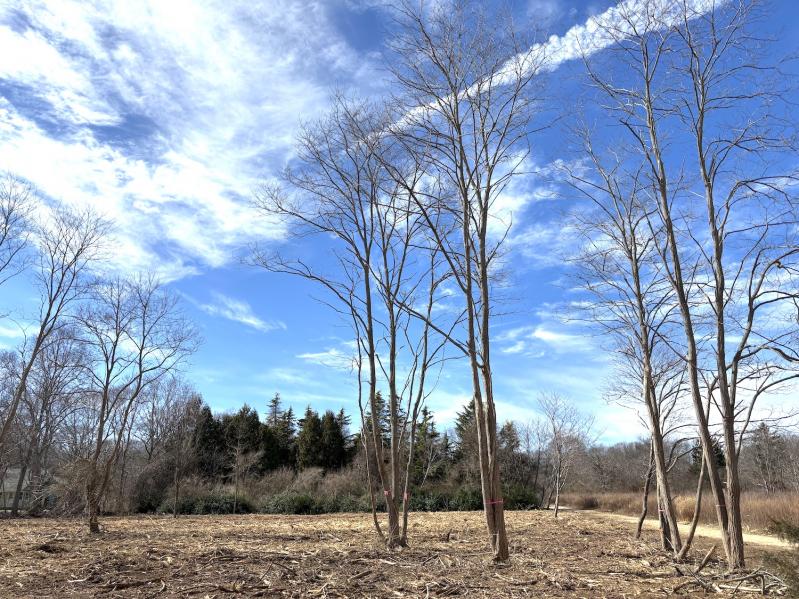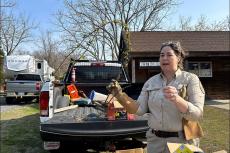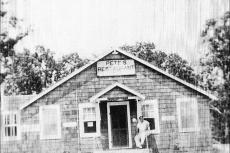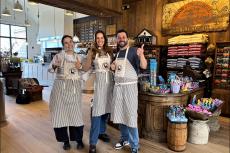East Hampton Town completed a pilot invasive species removal project at the 42-acre Springs Park on March 18. The park was closed while the work was being done, and town employees who spent the day guarding the gates estimated that 80 people had to be turned away.
While Scott Wilson, the town’s director of land acquisition and management, said no statistics regarding use exist, he surmised that it is the most-used park in the town. In a March 6 resolution, the town board had agreed to pay $23,112 to Jackson Dodds and Company to remove approximately an acre of autumn olive, and the crew was just cleaning up. Mr. Wilson surveyed the scene.
“Most people who are upset that we’re doing anything don’t understand what an olive is, what it looks like, how fast it grows,” he said, pointing out a cluster of the invasives widespread across the park. “It’s a great excuse not to have to pick up after your dog, too. From our perspective, this is a seeand-control-your-dog situation.” Indeed, piles of poop were nearly as widespread as the invasives. The colloquial name for the park, the Springs Dog Park, highlights their presence.
“If we didn’t do this, it’ll be like a jungle, this entire park, including this trail we’re standing on,” Mr. Wilson said. “If we didn’t constantly cut back, you would have nothing. This was a 100-percent unusable acre. A year from now it’s going to look like that grassy field over there.”
“If you don’t get the root, you’re in a situation where it just grows back,” Mr. Dodds said in a phone call. “If you cut it down, you’re just making it angry.” He said his equipment was able to destroy the plant’s roots. “We didn’t clear-cut. There was a large portion that was all autumn olive. Now we’ve provided an open space for natives to regenerate.”
The plant grows thickly, making passage through a grove of it extremely difficult.
Mr. Wilson walked by a green “compostable” dog bag dangling, full of excrement, from the branch of one autumn olive. Perhaps it was a perfect analogy for what the park has become, since it was bought with money from the community preservation fund in 2002.
When Carol Buda, a Springs resident, scolded Mr. Wilson at last Thursday’s town board meeting for not adhering to the town’s 2009 management plan for the park, allowing it to become overrun with invasives, she was ignoring the fact that the C.P.F. also did not contemplate a 20-acre dog park as the final use when it was purchased.
“I’m here to discuss what some of us now call the mismanagement plan for Springs Park,” she told the board. “This plan was poorly executed. Invasive plants were allowed to choke out native growth. This plan calls for grasslands in 80 percent of the park. Please note no grasslands exist.” She said the plan needed revision and accused Mr. Wilson of misrepresenting the test-area clearing. “Having huge open fields and sight lines makes the park more dangerous and more difficult for people to control their dogs.”
Back at the park, Mr. Wilson passed by a number of trees, flagged for preservation. “We’re not trying to rob people of shade. We’re trying to control the overgrowth of invasive species. We’re trying to recapture some of these areas where there could be native grass.” In fact, in the cleared acre, a number of larger black locust trees, themselves invasive, were left. A compromise.
“I think change is always hard,” Councilman Ian Calder-Piedmonte, the town
board’s liaison to the Springs Park Committee, said in a phone call. “At the end of the day, when this settles, I’m hoping it will be a better park. The goal was to do this as an experiment.”
Springs Park was purchased from Russell Ireland. When he owned it, it was known as the Springs Nursery. The park’s management plan highlights the importance of its habitat: “The former nursery has become the home of a diversified array of birds and animals; deer, box turtles, and squirrels are in residence here.”
In the seven years between purchase and plan, the town allowed the space to “evolve naturally.” There were no rules. In time, “the primary use has become an area for dogs and their owners to roam in a protected and fenced environment.” Noting that “the presence of so many unleashed dogs has generated some concern,” the town nevertheless hoped the plan would “help facilitate a community-friendly atmosphere where all can feel welcome and safe.”
It’s unlikely the park is much used by non-dog owners. “I love walking here when I do come,” Mr. Wilson said, “but I don’t have a dog anymore, so I almost never do. It’s uncomfortable.”
Of significance is that, when it was bought, the park was home to the field sparrow, listed in the 2025 State of the Birds report as a “tipping point” species that has lost more than 50 percent of its population since 1970. According to All About Birds, a Cornell Lab of Ornithology website, field sparrows require “shrubby grasslands or overgrown weedy fields.” Autumn olive chokes out that habitat completely. Field sparrows nest on the ground, meaning that their eggs and nestlings can be put at risk by off-leash dogs.
“The management plan that is being developed, late fall mowing, and the protection of open spaces will increase the amount of breeding habitat for all avian types,” reads the 2009 plan. “Hopefully the institution of the management plan will allow our avian friends to prosper and grow.”
The town clearly hasn’t kept up with that plan. The successful removal of a single acre of olives was a step toward proper maintenance of the C.P.F. investment, however.
Ms. Buda said an updated plan should include “suppression techniques” for mugwort, which has also taken over large swaths of the park, “and some plan to revegetate the area, or at the very least a plan to protect emerging native species.” It’s not clear why the town hasn’t at least planned to seed the area with native grasses. Since the area is bristling with invasives, Ms. Buda is correct in fearing that they will once again edge out the natives.
“We called it a pilot for a reason,” Mr. Wilson said as he walked toward the exit. “It will naturally repopulate, hopefully with grasses.” His department plans to mow the newly opened acre annually.
The park was reopened. A man pulled up and from his car bounded a large off-leash dog. “He’s friendly!” he called, from some distance.




